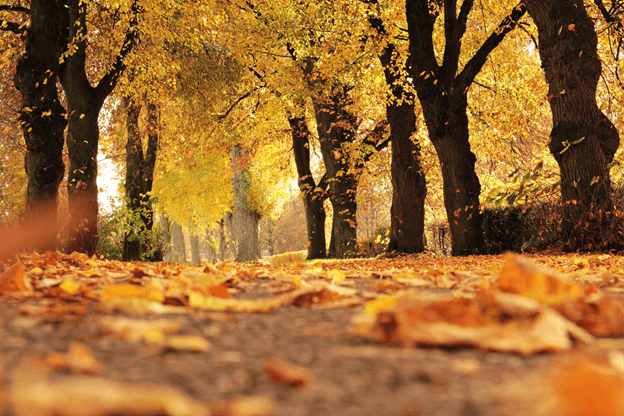We hope that you are enjoying our mini-retreats from Torri Shafer’s “Romancing the Soul”. Here’s our latest selection, exploring seeing a bigger picture while walking and observing meditatively. Enjoy!
Every morning when walk my dog down by the river, I encounter infinity and I never notice it. Often, I will use this time to plan my day or simply daydream. As I ponder the large questions like what to have for dinner, there is a universe of life throbbing around me, the very scope of which makes me smaller than the dust motes floating in the sun. I never see it. I drift by countless miracles. My life might run more efficiently because of this—after all, when I get to the office, I will know exactly what I have to do and in what order of priority—but should efficiency supersede beauty or be considered more precious than wonder?
In The Zen of Seeing, Frederick Franck writes, “We do a lot of looking: we look through lenses, telescopes, television tubes… Our looking is perfected every day—but we see less and less. Never has it been more urgent to speak of seeing… we are on-lookers, spectators, “subjects” that look at “objects.” Quickly we stick labels on all that is, labels that stick once—and for all. By these labels we recognize everything but no longer see anything.”
For example, I labeled today a perfect fall day and because of that I missed it entirely. Walking amongst the radiant gold and green trees strung with trails of red ivy, my attention was centered not on this amazing kaleidoscope around me but, typically, on my inner world. If I had skipped the all-embracing label and embraced the canvas before me I would have experienced the wonder of the leaves themselves.
All summer the leaves shimmer with a brilliant green but that is not their true color. In actuality, leaves have always been every warm color of the spectrum but have been camouflaged green by their chlorophyll. Now as the chlorophyll slowly drains away, the tree sheds its cloak of green and reveals its true splendor. Suddenly, the leaves are each unique tapestries of vivid richness. The trees, indifferent to their own beauty, release the leaves to float down on waves of air like words of a poem. My inner landscape is so much more pedestrian and dull than what is around me. None of my thoughts could compare in richness and complexity to a single gold and crimson leaf. Yet, many times my thoughts are what get my full attention.
If I move outside my thoughts and start to notice the details of what is around me, I start to lose that sense of aloofness between me and the life surrounding me. The path that I am walking on becomes less of a path and more of a delightful journey where schools of turquoise damsel flies float through the apricot and green fronds of tamarisk trees. It reawakens awe and refreshes me more than anything my mind could devise.
It not only strengthens a sense of connection but builds a sort of interaction that we crave from so much solitary time in our own thoughts. Jon Kabot Zinn sums it up eloquently when he writes, “Some ancient native traditions believe that the world feels our seeing and sees us right back, even the trees and bushes, even the rocks. And certainly, if you have ever spent a night alone in the rain forest or the woods, you will know that the quality of your seeing and of your being is felt and known by more than the human world. You will sense that you are definitely being seen and known as you really are, if not how you normally think of yourself, and that whether you are comfortable with it or not, you are an intimate part of this one animate and sensuous world.”
Walking and Seeing Meditatively
All walking is discovery. On foot we take the time to see things whole. ~Hal Borland
Meditative seeing is a challenge, but it truly allows one to see in a deeper, more intrinsic way. There are several tips to see meditatively. First, don’t choose one object and block others in your sight. When your eyes are focused on one central object, the rest of the objects are ignored; just like when you listen closely to one person and unconsciously ignore other noises in the background.
All this selective seeing or hearing is done by the mind. It is said that more than 90% of information is ignored or discarded because of mind interference. Whenever you see anything, you see it from the perspective of the mind. The mind brings its own conditioning and colors the object in different light. Your mind immediately makes an opinion about what you see.
So, instead of focusing on any one object, try to see the whole canvas. When you see without choosing any object, you come to your center, becoming conscious and aware. You move beyond autopilot into the awe of being. You are no longer the invisible witness but a symbiotic part of the environment.
There is no need to verbalize in your mind what you see; you don’t need a commentator to experience reality. You confront reality firsthand and not via your mind. This is a challenge because it is an automatic habit of the mind to label something and then judge it accordingly, choosing to focus on it or discard it. As Franck said, “When I “look” at the world and label its phenomena, I make immediate choices, instant appraisals—I like or dislike, accept or reject what I look at, according to its usefulness to the “me.”
When you cease choosing and labeling what you see and your complete, unwavering attention is on your visual sense, the usual perception of “me” and “not-me” are suspended and a deeper connection is felt with what you see.
The practice of avoiding pinpointing and labeling what we see, also helps us to look at our life experiences in a new way. Rather than labeling situations as good or bad, we can look beyond the individual situation to the bigger picture which gives us greater equanimity and peace of mind. It also gives us freedom from rumination and regrets and allows us to embrace fully whatever life offers us.
***
Torri’s book is available for purchase here.


Recent Comments